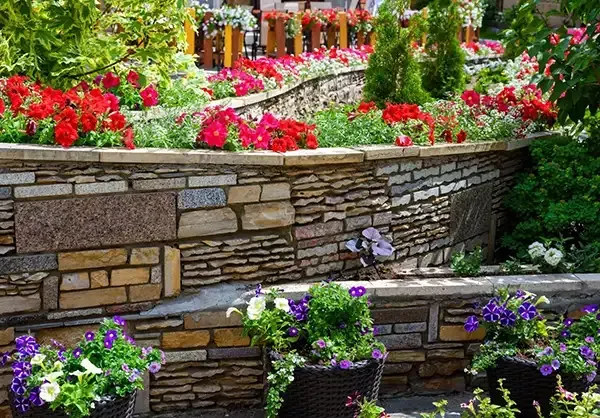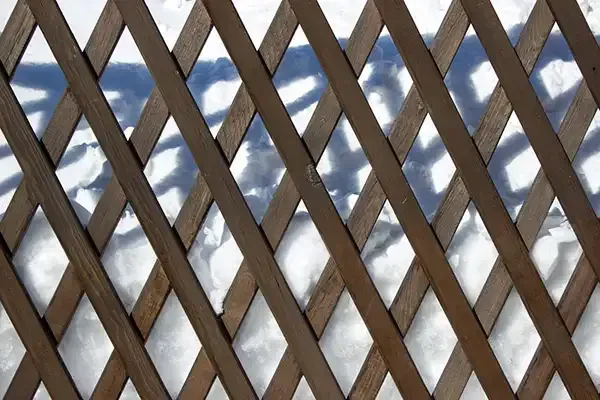Why Do Wood Retaining Walls Offer Long-Term Durability?
When considering the long-term durability of wood retaining walls, you might wonder what sets them apart from other materials.
It's not just about the type of wood used; factors like construction techniques and ongoing maintenance play crucial roles in their resilience.
For instance, using rot-resistant species and implementing proper drainage can significantly enhance their lifespan.
But there's more to it—understanding how these elements work together can help you make informed decisions for your projects.
What specific practices can ensure that your wood retaining wall stands the test of time?
Types of Wood for Retaining Walls
Selecting the right wood for your retaining wall is crucial for durability and aesthetics. Here are some options to consider:
Pressure-Treated Lumber
Pressure-treated lumber is affordable and resistant to rot and insects due to its preservative treatment.
- Cost-effective: Budget-friendly and widely available.
- Protection: Resists rot and insects.
- Longevity: May not last as long as other options.
A great choice for those seeking a low-cost, functional option.
Cedar and Redwood
Cedar and redwood are naturally resistant to decay and offer a high-end, long-lasting look.
- Natural resistance: No chemical treatment needed.
- Aesthetic appeal: Rich, attractive tones.
- Higher cost: More expensive than pressure-treated lumber.
Ideal for those looking for a premium, durable option.
Composite Wood
Composite wood is made from wood fibers and recycled materials, offering a low-maintenance, eco-friendly alternative.
- Low maintenance: Easy to maintain.
- Durability: Resists moisture, rot, and insects.
- Sustainability: Made from recycled materials.
Perfect for those seeking durability and minimal upkeep.
Hardwoods (Oak & Maple)
Hardwoods like oak and maple provide strength and an elegant appearance, though they come at a higher cost.
- Strength: Highly durable.
- Visual appeal: Adds a refined look.
- Cost & availability: More expensive and less common.
A top choice for a high-end, long-lasting design.
Consider your budget, desired aesthetic, and maintenance preferences when choosing wood. Each type offers unique benefits, so pick the one that suits your needs best.
Construction Techniques for Longevity
Creating a long-lasting wood retaining wall requires careful planning and construction techniques. Here are key steps to ensure your wall remains strong and functional for years to come:
Choose the Right Wood
Selecting the correct wood species is crucial for durability. Use naturally rot-resistant woods like cedar or redwood to ensure longevity and resistance to moisture and decay.
- Cedar: Naturally resistant to decay.
- Redwood: Offers excellent durability and aesthetics.
Proper Site Preparation
A solid foundation is essential for a stable retaining wall. Begin by excavating the area and ensuring it is level to prevent shifting or instability.
- Excavate: Clear the area and level the ground.
- Foundation: A flat base will prevent future wall failure.
Incorporate Drainage Solutions
Effective water management is essential to prevent wall damage. Install weep holes or drainage pipes behind the wall to relieve water pressure and reduce the risk of warping or collapse.
- Weep Holes: Allow water to escape, reducing pressure.
- Drainage Pipes: Help direct water away from the wall.
Anchor the Wall Properly
Stabilize the wall by burying the bottom row of timbers into the ground. This provides additional strength and resists lateral forces that may cause the wall to shift.
- Anchor: Bury the bottom row of timbers.
- Stability: Prevent shifting under pressure.
Use Quality Fasteners
To ensure the longevity of the wall, use high-quality fasteners like galvanized or stainless steel nails and screws. These materials resist rust and corrosion, keeping the structure secure.
- Galvanized or Stainless Steel: Prevents rust.
- Secure Fastening: Keeps the wall intact.
By following these construction techniques, you'll build a wood retaining wall that not only enhances your landscape but also stands the test of time.
Maintenance Practices for Durability
Even with the best construction practices, maintaining your wood retaining wall is crucial for ensuring it lasts over time. Here are some key maintenance practices to keep your wall in top condition:
Regular Inspections
Regularly check your wall for signs of wear and tear. Look for warped boards, cracks, or insect infestations that could cause long-term damage.
- Inspect: Identify damage early to prevent costly repairs.
- Look for: Warping, cracks, or pests.
Apply Wood Preservative
To protect the wood, treat it with a high-quality preservative before and after installation. Reapply every few years, particularly in areas exposed to moisture, to extend the life of your wall.
- Before and After: Apply preservative to new and existing walls.
- Reapply: Treat every few years, especially in moist areas.
Keep the Area Clear
Avoid allowing debris and vegetation to build up around the wall. Overgrown plants can trap moisture, leading to decay and weakening the structure.
- Clear Vegetation: Prevent plants from holding moisture against the wood.
- Avoid Debris: Keep the area clean to prevent rot.
Ensure Proper Drainage
Effective drainage is vital for keeping your wall stable. Ensure there is no pooling water at the base, which can cause the wood to weaken and decay over time.
- Drainage: Prevent water from pooling near the wall's base.
- Protect: Proper water flow reduces the risk of damage.
Replace Damaged Boards
Promptly replace any damaged or rotting boards to maintain the integrity of the entire structure. Ignoring minor issues can lead to bigger problems.
- Replace Promptly: Fix minor damage before it worsens.
- Preserve Integrity: Timely repairs keep the wall strong.
By following these maintenance steps, you'll ensure your wood retaining wall remains sturdy, functional, and visually appealing for years to come.
Wood retaining walls offer long-term durability when constructed with the right materials, techniques, and maintenance practices.
By selecting the appropriate wood, ensuring proper drainage, and anchoring the wall securely, you can create a stable, lasting structure.
Regular inspections, preservation treatments, and prompt repairs are key to maintaining the integrity of the wall, ensuring it continues to enhance your landscape for years.
With these efforts, wood retaining walls provide both beauty and strength, offering a sustainable and reliable solution for your outdoor space.
You might also like
Book a Service Today
We will get back to you as soon as possible
Please try again later
Get In Touch With A Professional Near You Today!
Having a retaining wall installed is able to provide a large increase in housing value to a homeowner and provides a solution that gets your retaining wall design project underway. As a homeowner, you should know that a landscape wall needs to look its best and when it does, it will most definitely add to the aesthetic of your home. Call one of our trusted team members today for a Free Quote!
Precision Retaining Walls
The region's leading professional Retaining Wall Company.
Call Us: 918-842-7333
All Rights Reserved | Tulsa Precision Walls |


